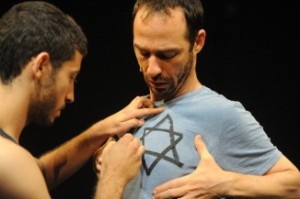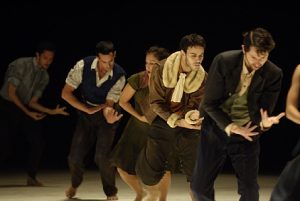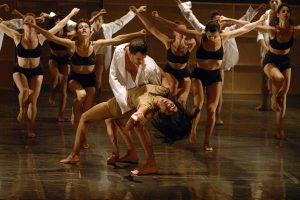Tel Aviv Dance Fest Rewires My Nervous System … and Ripples to San Diego
In a park I visited in Tel Aviv, there’s a piece of workout equipment where you step into two foot channels and move your legs back and forth; it doesn’t take much effort, but when you get off, you’re wobbly, as if your nervous system got disconnected, and you have to create new neural pathways. That’s how I felt, seeing some of the work at the International Exposure dance festival in Tel Aviv December 4-8.
Watching Nadar Rosano’s “ASPHALT,” for instance, I had to hunt for language to describe the quirky, fresh style – I came up with “flappus interruptus” for a lunge where a dancer extended both arms to the sides and used them like staccato wings. And I had such a visceral reaction to the club-flavored moves bubbling and jerking through the dancers’ bodies in “House” by L-E-V (Sharon Eyal and Gai Behar) that I fell into bed that night and slept until almost 11, missing breakfast … and if you’ve ever had an Israeli hotel breakfast, missing it is no small thing.
Here’s a bit of “House,” featuring Eyal in the shiny black unitard and, at the end, my favorite of her dancers, whom I nicknamed Gumby Girl. (BTW, “lev” is Hebrew for “heart.”)
International Exposure is an annual showcase of dance by some 40 contemporary choreographers and/or companies. Festival central was the Suzanne Dellal Dance Centre, which has three theaters and studio venues; several shows also took place at Machsan 2, a very cool black box theater at the Jaffa wharf. All of the work was by Israeli artists; the festival’s purpose is to acquaint presenters and journalists with Israeli contemporary dance – which is exploding.
Israel has long been on the international dance map. The most established groups, Batsheva and the Kibbutz Contemporary Dance Company, started in 1964 and 1970, respectively, and a second wave, including Inbal Pinto and Vertigo, emerged in the early 1990s. Those companies already tour extensively, and San Diego audiences have had the chance to catch Batsheva, Inbal Pinto, and Vertigo, thanks to UCSD ArtPower.
And it turns out the best-known companies are just the strongest blips on the radar. Underneath, there’s a clamor of newer dance makers and a refreshingly messy range of work, from deeply realized dances that thrilled me, to promising pieces by choreographers still refining their voices, to stuff that’s tedious and weak.
Among the International Exposure standouts (in addition to the work by Rosano and L-E-V mentioned above):
– I’m starting with the Kibbutz Contemporary Dance Company, directed by Rami Be’er because – mark your calendar! – it’s coming to the Luckman Theater in Los Angeles on February 22. At International Exposure, the company did “Undivided Void,” which flows organically from tight formations with lunges and swift changes of direction (think “Crouching Tiger, Hidden Dragon”) to solos and duets that show off individual styles. Several of the 16 dancers knocked me out: two men whose delicate hands create filigrees in the air, a crop-haired woman with gorgeously articulated lines, a woman I dubbed “ball of fire.” Most fascinating of all, a slender, shapely woman starts with her back to us, doing sinuous hip circles, like a Mixmaster on slow … and then turns around and reveals masculine-looking features. At one point, all of the men surround her menacingly, and later all of the women are wearing black and all the men white, but she’s in beige; and although the stated theme involves a yearning for completeness, what stuck with me was the play with our either-or conventions of gender. In Los Angeles, the company is doing “If At All.” You can see a video preview here.
 – “We Love Arabs” is a dance-theater piece by Hillel Kogan that, remarkably, succeeds in being both cheeky and profound. Starting out center-stage, Kogan parodies a pretentious lecturer on “the aesthetics of the body in space” who senses “a place that is not me” resisting him. He decides “The place that is not me belongs to an Arab” and that he needs to work with an Arab dancer – Adi Boutrous. Keeping the tone light but touching on wrenching issues – quite a balancing act – Kogan and Boutrous “mark” each other, because how would an audience know from their appearance which is the Arab and which the Jew? Ultimately, Kogan concludes that what unites Israeli Jews and Arabs is their love for hummus. He simultaneously carries Boutrous over his shoulder and keeps one arm around a big bowl of hummus; then they trade, and Boutrous carries him and the hummus. It’s slapstick and clownish, yet it’s also touching … especially at the end, when they feed each other. By the way, it’s worth noting that, like about half of the choreographers at International Exposure, Kogen has worked with Batsheva.
– “We Love Arabs” is a dance-theater piece by Hillel Kogan that, remarkably, succeeds in being both cheeky and profound. Starting out center-stage, Kogan parodies a pretentious lecturer on “the aesthetics of the body in space” who senses “a place that is not me” resisting him. He decides “The place that is not me belongs to an Arab” and that he needs to work with an Arab dancer – Adi Boutrous. Keeping the tone light but touching on wrenching issues – quite a balancing act – Kogan and Boutrous “mark” each other, because how would an audience know from their appearance which is the Arab and which the Jew? Ultimately, Kogan concludes that what unites Israeli Jews and Arabs is their love for hummus. He simultaneously carries Boutrous over his shoulder and keeps one arm around a big bowl of hummus; then they trade, and Boutrous carries him and the hummus. It’s slapstick and clownish, yet it’s also touching … especially at the end, when they feed each other. By the way, it’s worth noting that, like about half of the choreographers at International Exposure, Kogen has worked with Batsheva.
– The Inbal Pinto work I saw previously (at UCSD) was “Oyster,” a Felliniesque piece so visually inventive that it set the bar for this company in the stratosphere. “Dust,” premiered by Pinto and co-director Avshalom Pollak at International Exposure, doesn’t reach that level, but there’s a similarly magical feel to this loose narrative involving a classroom of twitching students who fall into acrobatic backbends, a schoolmaster out of Monty Python’s “Bureau of Silly Walks,” and a figure garbed in a black cap and robe like Death in the Ingmar Bergman film “The Seventh Seal.” A bit with a rubber-legged chair is genius, and the closing image felt deeply satisfying. Less successful were some visual elements – an opening video and illustrated flip cards – that were intriguing but didn’t feel integral.
– Batsheva’s artistic director, Ohad Naharin, already has star status, so the company used International Exposure to showcase two alumni, Hofesh Schechter and Danielle Agami, who now have their own troupes. It was like taking a bath in testosterone – especially in an intimate studio setting – to see an all-male cast traveling in urgent formations in Schechter’s combative “Uprising.” Several of the men, from Batsheva’s training ensemble, looked more than ready to graduate to the professional troupe. Agami’s all-female “Shula” sparkled in earthy folk dance-flavored sections but was too often static. By the way, Agami is now based in Los Angeles; if you happen to be in L.A. for Christmas, you can catch her Ate9 Dance Company this Tuesday at the L.A. County holiday celebration at the Dorothy Chandler Pavilion.
– Sentimental songs – “Tumbalalaika,” “Danke Schoen” – and a bittersweet story contrast brilliantly with angular, unsentimental movements and antic comedy in Barak Marshall’s “Rooster.” Created in 2009, the Lester Horton Award-winning “Rooster” is a full-fledged stage show, with a narrative drawn from a Yiddish short story and several other sources and a cast including an opera singer. A co-production of the Suzanne Dellal Centre and the Israeli Opera, it’s still touring internationally. The cast had just returned from Russia when they presented excerpts in a studio showing at International Exposure. Someone please bring “Rooster” to San Diego; I want to see the whole thing.
– There was swell theatricality in “Bodyland” by the Yossi Berg & Oded Graf Dance Theatre: humorous text as well as movement from the five men in the international cast, using their bodies to represent their home countries; giant mylar constructions including hands and a foot (by Sille Dons Heltoft) wafting behind them, both menacing and dreamlike; and a madcap approach with intentionally ungainly movement. I saw this piece after hearing raves about it, and it didn’t grab me as much as I’d expected; still, I’d be eager to see more from this inventive pair.
Two other studio showings made my highlights list: Vertigo and Roy Assaf. (Alas, I missed the concert show of Assaf’s “Girls.”) And the list of artists I hope to see more of also includes Dafi Altabab, Michael Getman, and Yasmeen Godder. International Exposure exposed a few clunkers, as well: a piece by Ella Ben-Aharon that involved rolling around in rice and not much else; “Polly & the Crackers,” in which Osnat Kelner so thoroughly achieved her intention, to spoof a mock-awful rock group, that it just felt like watching an awful rock group.
Ten time zones separate Tel Aviv and San Diego, so what’s happening in dance in Israel, however electric, may seem remote. But ripples from the Israeli dance boom are reaching here, and not only via touring companies. Several Israeli dance makers now live in the U.S., for instance, Agami in Los Angeles. And San Diego dance artist Kyle Sorensen is spending a year in Israel on a Fulbright Fellowship, making a film about contemporary dance there; his wife, Gina Bolles Sorensen, is also involved in the project, and it’s certain to reverberate in their work as directors of somebodies dance theatre. Before long, Gaga – the innovative training method developed by Batsheva’s Naharin – may become part of the dance vocabulary here.

Award-winning dance journalist Janice Steinberg has published more than 400 articles in the San Diego Union-Tribune, Dance Magazine, the Los Angeles Times, and elsewhere. She was a 2004 New York Times-National Endowment for the Arts fellow at the Institute for Dance Criticism and has taught dance criticism at San Diego State University. She is also a novelist, author of The Tin Horse (Random House, 2013). For why she’s passionate about dance, see this article on her web site, The Tin Horse


